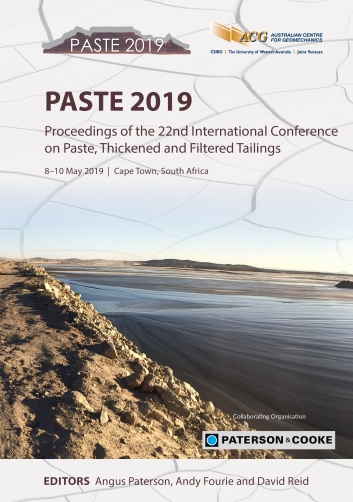Disposal of tailings and the mining industry perspective: a case study of the Cuiabá Mine

|
Authors: Gomes, MFM; Filho, JGM; Pinheiro, JA; Crystal, C |
DOI https://doi.org/10.36487/ACG_rep/1910_14_Gomes
Cite As:
Gomes, MFM, Filho, JGM, Pinheiro, JA & Crystal, C 2019, 'Disposal of tailings and the mining industry perspective: a case study of the Cuiabá Mine', in AJC Paterson, AB Fourie & D Reid (eds), Paste 2019: Proceedings of the 22nd International Conference on Paste, Thickened and Filtered Tailings, Australian Centre for Geomechanics, Perth, pp. 219-231, https://doi.org/10.36487/ACG_rep/1910_14_Gomes
Abstract:
One of the methods that has been studied for the disposal of tailings by the mining industry is dry stacking. Several studies have indicated that the use of filtered tailings is feasible under certain technical and operational conditions. The requirements for deposition, and characterisation of the tailings properties, must be obtained through a wide range of field and laboratory tests. These parameters are key to determining the behaviour of the material during the dewatering process, the optimum moisture content and the maximum density of the tailing cake, as well as the physical and environmental stability of the projected geotechnical structure. The operational aspects related to the handling of the material are also vital to determine the placement of the filtered tailings on the facility. In addition, the advantages with respect to water consumption, reduced and/or flexible stack footprints and geometries, seepage control requirements, closure/reclamation costs and public perception of risk can result in dry stacking being selected as an economically beneficial alternative, particularly if life-of-mine risks and costs are appropriately considered. As with any conventional tailings management approach, careful and diligent planning, engineering and operational controls, quality assurance/quality control (QA/QC), instrumentation and monitoring are required to manage risks and uncertainties. This paper presents the criteria that need to be evaluated in the evaluation of filtered tailings as a business case, based on the experience of the authors developing such projects within the minerals industry.
Keywords: dry stacking, mining industry
References:
ASTM International 2012a, ASTM D698: Standard Test Methods for Laboratory Compaction Characteristics of Soil Using Standard Effort (12 400 ft-lbf/ft3 (600 kN-m/m3)), ASTM International, West Conshohocken.
ASTM International 2012b, ASTM D1557: Standard Test Methods for Laboratory Compaction Characteristics of Soil Using Modified Effort (56,000 ft-lbf/ft3 (2,700 kN-m/m3)), ASTM International, West Conshohocken.
BVP Engenharia 2017, Relatório AA-100-BV-0498-201-RF-001 – Acompanhamento técnico das atividades de aterro experimental com rejeito total na Mina de Cuiabá.
Concha, FA 2014, ‘Solid–liquid separation in the mining industry’, Springer, Fluid mechanics and its Applications (series), vol. 105.
Cox, C & Traczyk, F 2002, ‘Design features and types of filtration equipment’, in AL Mular, DN Halbe & DJ Barratt (eds), Mineral Processing Plant Design, Practice and Control, vol. 2, Society for Mining, Metallurgy & Exploration, Littleton, pp. 1342‒1357.
Ekberg, B & Haartti, J 1993, ‘Capillary filtration – the harnessing of natural forces to serve the process industry’, Proceedings of the XVIII International Mineral Processing Congress, The Australasian Institute of Mining and Metallurgy, Melbourne,
pp. 1303‒1308.
Ekberg, B & Woitkowitz, S 1988, ‘Cake-forming wet filtration without gas throughput with the new ceramic Ecosuc disc filters’, Aufbereitungs-Technik, vol. 28, no. 4, pp. 193‒196.
Hatch Engenharia e Consultoria 2017, Relatório de Projeto AA-134-HA-0497-267-RT-002 – Reconceituação de disposição de rejeito e Estéril da Mina de Cuiabá e CDS.
Lara, JL, Pornillos, EU & Muñoz, HE 2013, ‘Geotechnical-geochemical and operational considerations for the application of dry stacking tailings deposits – state-of-the-art', in RJ Jewell, AB Fourie, J Caldwell & J Pimenta (eds), Proceedings of the 16th International Seminar on Paste and Thickened Tailings, Australian Centre for Geomechanics, Perth, pp. 249‒260.
Lotzien, K, Jung, RG & Janitschek, R 1988, ‘Filtration without air throughput of filter material’, Aufbereitungs-Technik, vol. 28, no. II, pp. 628‒636.
Outotec 2010, Outotec Larox cc. product information brochure, Outotec, Espoo.
Sutherland, KS 2005, Solid/Liquid Separation Equipment, Wiley-VCH Verlag GmbH & Co, KGaA, Weinheim, Baden-Württemberg.
Testwork Desenvolvimento de Processos 2017, Relatório técnico No 017-2017 – Testes de Processo do rejeito da Mina de Cuiabá e CDS.
Wakeman, RJ & Tarleton, ES 2006, Solid/liquid Separation: Equipment Section and Process Design, Elsevier Science, Oxford.
Walm Engenharia Tecnologica Ambiental 2018, Relatório técnico AA-157-WA-0498-267-RT-006 – Resultados dos ensaios de campo e consolidação dos parâmetros de projeto.
© Copyright 2025, Australian Centre for Geomechanics (ACG), The University of Western Australia. All rights reserved.
View copyright/legal information
Please direct any queries or error reports to repository-acg@uwa.edu.au
View copyright/legal information
Please direct any queries or error reports to repository-acg@uwa.edu.au


